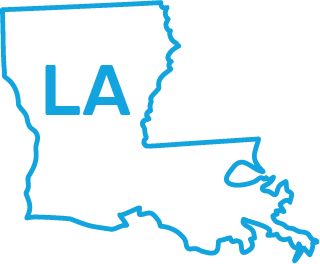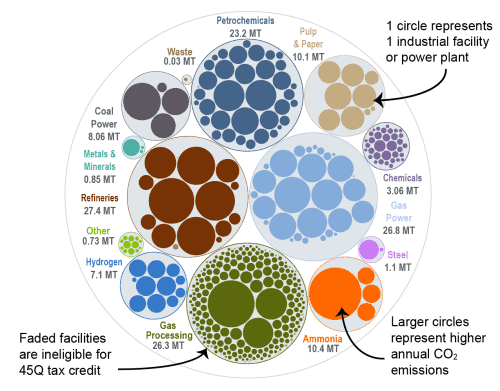Louisiana Carbon Capture Opportunities

Carbon management is poised to play a key role in lowering emissions across a variety of sectors in Louisiana and bringing jobs and private investment to the state. Of the 401 industrial and power facilities in the state, 340 are eligible for the 45Q federal tax credit. These 340 facilities emit nearly 145 million metric tons of carbon dioxide (CO2) annually, representing 99 percent of total annual CO2 emissions in the state.
Louisiana has taken significant steps in recent years to capitalize on its potential for carbon management and build out a supportive regulatory framework. In 2023, Louisiana was granted Class VI primacy, meaning the state has primary enforcement authority over the permitting process for the permanent storage of CO2 in geologic storage wells. It is one of four states with this authority, alongside North Dakota, Wyoming, and West Virginia.

Industrial and Power Facilities in Louisiana
Louisiana has 340 facilities that are eligible for the 45Q tax credit. The state’s gas processing industry represents the highest proportion of these facilities, at 184, and is also the second highest emitter. Louisiana’s highest emitting sector is gas power, which has 27 eligible facilities. Emissions from these 27 gas power plants alone represent nearly 20 percent of the state’s total annual CO2 emissions.
Louisiana also has 35 petrochemical facilities, 34 chemical facilities, 14 refineries, 11 hydrogen facilities, four coal power plants, and 31 other 45Q-eligible facilities. In total, these 340 facilities emit approximately 145 million metric tons of CO2 annually, representing 99 percent of the state’s annual CO2 emissions.
Louisiana also has significant potential to safely store captured CO2 underground in geologic formations across the state. The state was granted Class VI primacy in 2023, giving it primary enforcement authority over the permitting process for the storage of CO2 in geologic storage wells. As of June 2025, the state has proposed Class VI projects in 18 parishes. In April 2025, the Louisiana Department of Energy and Natural Resources issued one draft permit to Hackberry Carbon Sequestration, LLC in Camerson Parish.

Sources: EPA GHGRP, 2024. Bauer et al., NATCARB, 2018.
Louisiana has long recognized the benefits of carbon management and has created a favorable legislative context to spur deployment. The Louisiana Geologic Sequestration of Carbon Dioxide Act (HB 661) was passed in 2009 and is the foundation for deployment in the state. The act includes four key facets: it authorized the Department of Natural Resources to create a regulatory scheme for the injection, use and storage of CO2; established state liability of injected CO2 after ten years of storage; created the Geologic Storage Trust Fund to manage and monitor the stored CO2; and granted the state the ability to use eminent domain in the case of geologic storage projects.
Former Governor John Bel Edwards prioritized carbon management in his administration. In 2020, Louisiana joined the CO2 Transport Infrastructure Memorandum of Understanding (MOU) and worked with partner states to create the Regional Carbon Dioxide Transport Infrastructure Action Plan, which includes potential policies for states to consider to facilitate carbon dioxide transport and storage project deployment. In 2022, Governor Edwards’ Climate Initiatives Task Force approved the state’s first-ever Climate Action Plan, recognizing carbon management’s role in addressing high-intensity and hard-to-abate emissions.
Under Governor Jeff Landry, the state has enacted a handful of additional bills affecting carbon management deployment. In 2024, this included:
- HB 1: Appropriations to the Carbon Dioxide Geologic Storage Trust Fund
- HB 937: An act clarifying existing laws related to eminent domain in Louisiana
- HB 516: An act requiring additional CO2 storage regulations, including prohibiting storage facilities within two miles of certain areas, developing emergency response plans and community notification systems, and annual well testing.
- HB 966: An act streamlining the regulation of CO2 storage related to stakeholder activity and landowner responsibility, and an act concerning unitization, pooling, and consolidation of CO2 reservoirs.
A full list of enacted carbon management legislation from the 2024 session can be found here.
In 2025, Louisiana had several carbon management related bills moving through the legislative process. As of mid-June 2025, four bills had been sent to the Executive for signing:
- HB 548: This bill dedicates 30 percent of revenue from CO2 storage or pipeline activity on property owned by the Department of Wildlife and Fisheries to the local parishes where the property is located, with the remainder directed to the Wildlife and Fisheries Conservation Fund. It creates an exception to the standard state revenue distribution for CO2 storage on state-owned lands specifically managed by the department or commission.
- HB 304: Related to carbon management infrastructure, this bill requires expropriation hearings to be held in the parish where the property is located, while keeping other existing procedures in place.
- HB 691: Establishes stricter public safety and accountability requirements for CO2 storage in Louisiana.
- SB 244: Outlines the restructuring and reorganization of the Department and Conservation of Energy in Louisiana, previously known as the Department of Energy and Natural Resources. This department oversees the state’s CO2 storage program.
To see real-time updates on Louisiana’s active carbon management legislation, view our State Legislative Tracker.
This bubble diagram shows the number of facilities and corresponding annual CO2 emissions for each industry in Louisiana. The darker large bubbles are eligible for the 45Q carbon capture tax credit, while the faded bubbles are too small to be eligible. The total amount of CO2 emissions in Louisiana is listed for each industry in million metric tons.

Source: EPA GHGRP, 2024.
Last updated: June 2025

